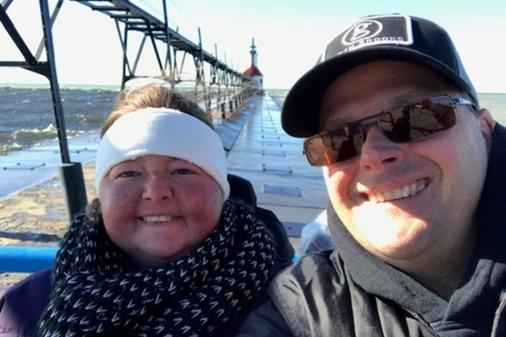
180 Medical Community member Clint has been living with urinary incontinence since he was 19 years old. While he has gone through some challenges along the way to finding a treatment and solution for his needs, he maintains a positive mindset and aims to live his life to the fullest.
Discovering the Root Cause of His Bladder Issues
For years, Clint secretly dealt with urinary incontinence issues. He used incontinence supplies, but he says that wasn’t just costly. It was also frustrating and stressful. “You’re always wondering, ‘am I going to make it to the bathroom in time?'”
Despite those issues, he says he never let his incontinence stop him. Still, he knew the only way to get help was to talk to a doctor.
It took some time to pinpoint exactly what the cause of his bladder issues was. He tried several different treatment options over the years, including biofeedback, InterStim therapy, and Botox injections for overactive bladder. These therapies showed some promise, but the beneficial impacts for Clint were ultimately short-lived.
However, when the InterStim unit was turned off, he noticed his foot began curling a bit. That’s when his doctor knew his bladder issues likely began with his nerves. Since he also experiences some balance issues and muscle twitches, his doctors thought he might have multiple sclerosis (MS). However, the tests and MRIs didn’t show that.
Eventually, his doctors discovered he had a rare chemical imbalance in his body that mimics some symptoms of Parkinson’s disease. This nerve disorder is known as Dopa-responsive dystonia (DRD).

What is Dopa-Responsive Dystonia (DRD)?
Dopa-responsive dystonia is a rare genetic disorder that affects the body’s ability to produce and process dopamine, a neurotransmitter that helps communicate messages between nerve cells.
People with DRD find that their condition typically appears in childhood or young adulthood, and it can cause a range of symptoms including tremors, stiffness, and difficulty with coordination and balance. In some ways, DRD resembles Parkinson’s disease, but it typically doesn’t respond well to the medications often used for treating Parkinson’s.
In Clint’s case, his DRD also impacted nerve communication with his bladder.

Finding Products and Resources at 180 Medical
Clint’s urologist did a full urodynamics study, and that was when they realized that he wasn’t just living with incontinence due to an overactive bladder. His bladder was also retaining nearly half of its urine even after voiding on his own. This is a common issue known as urinary bladder retention.
At that point, his urologist recommended using intermittent catheters to drain his bladder fully and referred him to a trusted catheter company: 180 Medical.
“My experience with 180 Medical has been top-notch,” he says. “Their specialists helped me figure out what would work for me, and they answered any questions I had with the utmost professionalism. Also, they have a great library of information and videos on their website to help educate yourself on how to use catheters.”

After trying out some free catheter samples from 180 Medical, Clint decided he preferred the flexibility and comfort of Medline Red Rubber Coudé Catheters. “With it being soft and the right size, I can hardly feel it going in.”
Also, when he knew he would be attending an outdoor event with only portable toilets (Porta-potties) for restrooms, he turned to our Catheter Specialists at 180 Medical for help.
“The staff at 180 Medical helped me find a short-term catheter solution that worked in the perimeters of my health insurance so I could cath safely in a Porta-potty,” he says. The SpeediCath Flex Pro Catheter has a full-length dry sleeve encasing the catheter tube to help facilitate no-touch catheterization, so he never had to worry about the sterility of his surroundings.

Clint’s Tips for People New to Using Catheters
Along the way, Clint has picked up some tips and tricks that he hopes can help other men and women who are new to using catheters.
1. Stay hydrated.
He says that when he was learning to cath, his urology nurse told him to keep drinking water. “She said, ‘Do not dehydrate yourself, and she was right.'”
Many people living with incontinence or using catheters sometimes assume that if they cut back on how much fluid they drink, they won’t have as many accidents or they won’t have to catheterize as often.
Clint found out that being dehydrated can make your bladder and urethra more irritated, and catheter insertion can feel uncomfortable. He says to listen to your healthcare pros and drink the right amount of water for your body every day.
2. Catheterize based on your prescribed schedule.
Clint shares that it’s important to follow your prescribed schedule, and cath at the times of day your doctor recommends.
“Catheterize on schedule, whether you think you have to go or not, because if you’re too late, it can end with a big mess.”
3. Find the right size and type of catheter that works for you.
Sampling from a variety of options helped Clint determine what felt and worked best for him. Everyone’s needs and anatomies are different. That’s why 180 Medical offers one of the widest varieties of catheter brands and types available for our customers.
4. Keep a “go-bag” for traveling.
Clint takes his photography hobby on the road a lot, and he loves to travel.
One of his top tips for traveling is to carry a small bag that includes all the catheterization supplies you’ll need for your trip. Clint packs his red rubber catheters, plenty of lubricant packets, gloves, and antiseptic wipes. The wipes can be useful especially if you find yourself somewhere without easy access to soap and clean water.
Your go-bag can be an easy all-in-one carrier you can take wherever you go.

5. Don’t be scared, and don’t let your condition hold you back from doing the things you love.
Clint says, “Let’s be honest. Cathing is not the ideal situation. I don’t think anyone’s first choice is to have to use catheters. Yes, it takes a little longer than just walking or rolling up to the facility and taking care of business. And there is prep work involved like making sure everything is as clean and sanitary as possible. But once you cath yourself a few times, it becomes second nature. Having said that, I’m glad I tried it. Catheterization has improved my quality of life.”

Living with Incontinence: Don’t Let Bladder Issues Hold You Back
Clint doesn’t know what lies ahead for him with his Dopa-responsive dystonia. He finds himself losing balance more easily these days. However, he doesn’t let it stop him.
When he’s not at work, he can often be found somewhere in the great outdoors with his camera. He loves taking pictures to showcase all the beauty there is still to be found in the world if you look.

You can check out more of Clint’s work on Flickr!
If you’re living with incontinence, overactive bladder, or another issue, you don’t have to keep struggling on your own. Don’t hesitate to reach out to your healthcare provider. The sooner you can get a diagnosis, the sooner you can find a treatment that works best for you.
Sometimes, this process involves trial and error to find what works. But with the right resources and the right mindset, Clint is proof that it’s still possible to live life to the fullest, even when living with incontinence or other bladder issues.
If you need to find the right catheter for you, contact 180 Medical to get started. We’re ready to provide the products, resources, and support that can help turn your life around.
Disclaimer: This content is not intended to substitute for professional medical advice, diagnosis, or treatment. For medical advice, please see your physician or another qualified healthcare provider.
